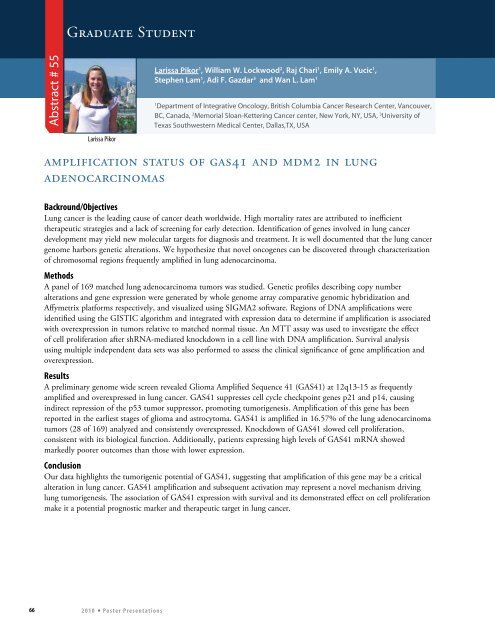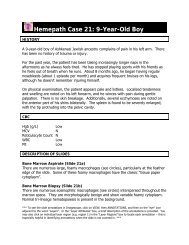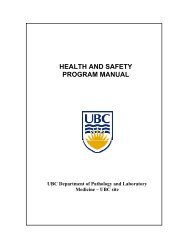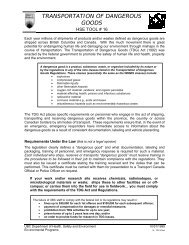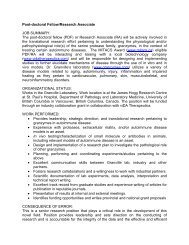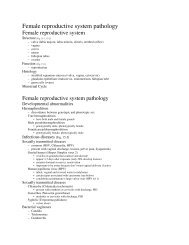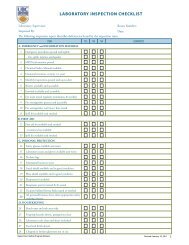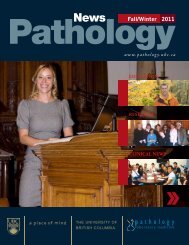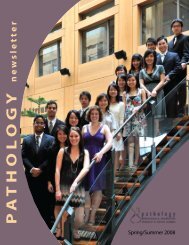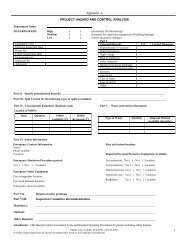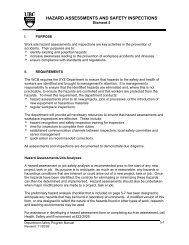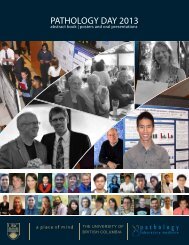Oral Presentations - Pathology and Laboratory Medicine - University ...
Oral Presentations - Pathology and Laboratory Medicine - University ...
Oral Presentations - Pathology and Laboratory Medicine - University ...
You also want an ePaper? Increase the reach of your titles
YUMPU automatically turns print PDFs into web optimized ePapers that Google loves.
Graduate StudentAbstract # 55Larissa PikorLarissa Pikor 1 , William W. Lockwood 2 , Raj Chari 1 , Emily A. Vucic 1 ,Stephen Lam 1 , Adi F. Gazdar 3 <strong>and</strong> Wan L. Lam 11Department of Integrative Oncology, British Columbia Cancer Research Center, Vancouver,BC, Canada, 2 Memorial Sloan-Kettering Cancer center, New York, NY, USA, 3 <strong>University</strong> ofTexas Southwestern Medical Center, Dallas,TX, USAamplification status of gas41 <strong>and</strong> mdm2 in lungadenocarcinomasBackround/ObjectivesLung cancer is the leading cause of cancer death worldwide. High mortality rates are attributed to inefficienttherapeutic strategies <strong>and</strong> a lack of screening for early detection. Identification of genes involved in lung cancerdevelopment may yield new molecular targets for diagnosis <strong>and</strong> treatment. It is well documented that the lung cancergenome harbors genetic alterations. We hypothesize that novel oncogenes can be discovered through characterizationof chromosomal regions frequently amplified in lung adenocarcinoma.MethodsA panel of 169 matched lung adenocarcinoma tumors was studied. Genetic profiles describing copy numberalterations <strong>and</strong> gene expression were generated by whole genome array comparative genomic hybridization <strong>and</strong>Affymetrix platforms respectively, <strong>and</strong> visualized using SIGMA2 software. Regions of DNA amplifications wereidentified using the GISTIC algorithm <strong>and</strong> integrated with expression data to determine if amplification is associatedwith overexpression in tumors relative to matched normal tissue. An MTT assay was used to investigate the effectof cell proliferation after shRNA-mediated knockdown in a cell line with DNA amplification. Survival analysisusing multiple independent data sets was also performed to assess the clinical significance of gene amplification <strong>and</strong>overexpression.ResultsA preliminary genome wide screen revealed Glioma Amplified Sequence 41 (GAS41) at 12q13-15 as frequentlyamplified <strong>and</strong> overexpressed in lung cancer. GAS41 suppresses cell cycle checkpoint genes p21 <strong>and</strong> p14, causingindirect repression of the p53 tumor suppressor, promoting tumorigenesis. Amplification of this gene has beenreported in the earliest stages of glioma <strong>and</strong> astrocytoma. GAS41 is amplified in 16.57% of the lung adenocarcinomatumors (28 of 169) analyzed <strong>and</strong> consistently overexpressed. Knockdown of GAS41 slowed cell proliferation,consistent with its biological function. Additionally, patients expressing high levels of GAS41 mRNA showedmarkedly poorer outcomes than those with lower expression.ConclusionOur data highlights the tumorigenic potential of GAS41, suggesting that amplification of this gene may be a criticalalteration in lung cancer. GAS41 amplification <strong>and</strong> subsequent activation may represent a novel mechanism drivinglung tumorigenesis. The association of GAS41 expression with survival <strong>and</strong> its demonstrated effect on cell proliferationmake it a potential prognostic marker <strong>and</strong> therapeutic target in lung cancer.66 2 0 1 0 * P o s t e r P r e s e n t a t i o n s


